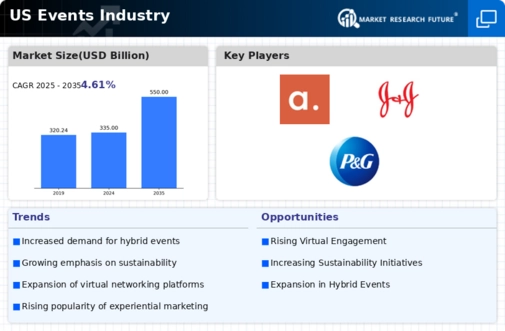Emphasis on Health and Safety Standards
The events market is witnessing an emphasis on health and safety standards, which has become a priority for organizers and attendees alike. As concerns about health and safety continue to shape consumer behavior, event planners are implementing rigorous protocols to ensure safe environments. This includes enhanced sanitation measures, crowd management strategies, and compliance with local regulations. In 2025, it is anticipated that events adhering to strict health and safety standards will attract a larger audience, potentially increasing attendance by up to 20%. This focus on safety not only reassures attendees but also enhances the overall reputation of the events industry market.
Shift Towards Personalization in Events
Personalization is becoming a crucial aspect of the events market, as attendees increasingly expect tailored experiences. Organizers are leveraging data analytics to understand attendee preferences and behaviors, allowing for customized event offerings. This trend is particularly evident in the rise of personalized agendas, targeted marketing, and bespoke networking opportunities. By 2025, it is projected that events featuring personalized elements will see a 25% increase in attendee satisfaction rates. This shift towards personalization not only enhances the attendee experience but also drives loyalty and repeat attendance, ultimately benefiting the events industry market.
Increased Corporate Investment in Events
Corporate investment in events is a significant driver of the events market. Companies are recognizing the value of live events for networking, brand promotion, and employee engagement. In 2025, corporate spending on events is expected to account for over 60% of the total market revenue, reflecting a strong commitment to face-to-face interactions. This trend is likely to continue as businesses seek to foster relationships and enhance their brand visibility through experiential marketing. The influx of corporate funds into the events industry market not only boosts revenue but also encourages innovation and creativity in event design and execution.
Growing Demand for Experiential Marketing
The events market is experiencing a growing demand for experiential marketing, where brands create immersive experiences for consumers. This trend is driven by the desire for deeper connections between brands and their audiences. In 2025, it is estimated that experiential marketing will represent approximately 30% of total marketing budgets for many companies. This shift towards experiential strategies is reshaping the events industry market, as brands invest in unique and memorable events that resonate with their target demographics. The focus on creating engaging experiences is likely to drive innovation and competition within the market.
Technological Advancements in Event Management
The events market is increasingly influenced by technological advancements that streamline event management processes. Innovations such as event management software, mobile applications, and virtual reality are enhancing attendee experiences and operational efficiency. For instance, the integration of AI-driven analytics allows organizers to gather real-time data on attendee engagement, which can lead to improved event strategies. In 2025, the market for event management software is projected to reach approximately $10 billion, indicating a robust growth trajectory. This technological evolution not only enhances the planning and execution of events but also contributes to the overall growth of the events industry market.














Leave a Comment